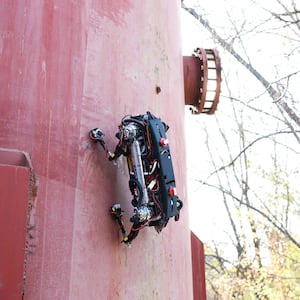How is real life like the plot of the movie Terminator 2? Let me count the ways.
A scarily powerful artificial intelligence based on a neural network? Check.
Humanity as close as it's ever been to an apocalypse? Check.
And a shapeshifting object made out of a liquid metal? Until now, it would’ve been a miss. But researchers in the U.S. and China have created an object made from microparticles embedded in liquid gallium that, when heated with magnets, melts into a liquid that can pass through the bars of a cage—just like the T-1000 did in the movie.
Don’t believe me? See for yourself:
There’s one important caveat: The video that the researchers made of the material’s great escape is stop motion. The material self-hardens but had to be recast into the shape of the Lego minifigure at the very end. “We can have a T-1000 that melts. Getting it to reshape and restore itself back—that's still an open challenge,” Carmel Majidi, a mechanical engineering researcher at Carnegie Mellon University who helped lead the study, told The Daily Beast.
The study containing this absolutely bone-chilling display was published on Jan. 26 in the journal Matter. And yes, the Terminator 2 reference in the video was intentional.
“One of the original drafts of the paper made reference to The Terminator and the T-1000, and I actually had it taken out just because of copyright reasons and all that,” Majidi said.
While the recreated T-1000 scene was a fun demonstration of the material’s capabilities, Majidi said that sea creatures were, in fact, the true inspirations. Sea cucumbers, for instance, can stiffen up in the face of danger—a trait which has long captivated materials science and robotics researchers. Such an attribute could allow a device to maneuver into tight spaces while soft and then harden to resist wear and tear.
The team of researchers based the new material on gallium, a so-called liquid metal due to the fact that it melts at around 86 degrees Fahrenheit. They embedded magnetic microparticles within the metal that allowed it to be moved or heated with magnets, then got to work testing it in different situations.
The material may also be helpful in removing foreign objects from organs. To test this, the researchers put the material into a model of a human stomach filled with water, where it liquefied and wrapped itself around a steel ball. Then, once it solidified again, it could leave the stomach—all within two minutes, demonstrating a very feasible application.
“In practice, [a foreign] object could cause gastrointestinal damage or even be life threatening,” the authors wrote in the study.
Next, they created a capsule of the material that contained fluorescein sodium, a salt used to diagnose problems in the cornea. The researchers again liquefied the material, this time to deposit the salt in the faux stomach, and tracked the model drug’s spread by how much of the water it stained. The material could even “stir” the drug to diffuse faster when magnetic energy made it rotate in a circle.
“This paper is quite impressive to me, and it reminded me of that movie, The Terminator,” Li Zhang, a micro and nanorobotics researcher at The Chinese University of Hong Kong, who was not involved in the study, told The Daily Beast. “It would be very cool if we could design this T-1000 liquid metal-based robot at a very small scale, and then deploy it inside of our body for some medical task.”
Existing soft robots and materials that can change from liquid to solid states often don’t have very much mechanical strength, Zhang said. In contrast, this material’s ability to bear loads when solidified suggests that it could one day serve as an “extra hand for surgery” inside a patient’s body, he said. One day, swallowing the surgeon might even become a reality.
However, Zhang said that he wished the researchers had chosen a different organ model for their drug delivery and foreign body clearing experiments. “The stomach is not that difficult to reach using an endoscope,” he said. “What I'm interested in is whether we can use this kind of technique, for example, in the small intestine, which is very long and tortuous.”
Majidi’s colleagues at Sun Yat-sen University in China were initially interested in these biomedical applications for the material but decided to tack on the extra nonmedical experiments once they saw what it could do. The researchers then demonstrated the material’s ability to solder and repair an electrical circuit; flow into a socket and harden into a universal screw that can fit any gap and support a 10 kilogram weight; and of course, melt à la T-1000 to escape a jail cell.
It’s unlikely that gallium, microparticles, and magnets will replace career welders anytime soon, but there could be certain niche cases where this material could help, Majidi said.
“If you can easily access a damaged area, you can just manually weld it,” he said. “This is more intended for those cases where something is very difficult or impossible to reach—you could still have electromagnets control the magnetic field in the vicinity, but you might have difficulty getting directly to that area.”
One such region may be outer space, said Zhang, who has also worked on engineering soft robots for inaccessible regions.
Right now, Majidi is studying the toxicity of liquid metals, including gallium, to living cells. A further wrinkle is that the human body rests at a temperature above gallium’s melting point. However, gallium-based alloys could be engineered to raise this property, Majidi added.
If this material will one day be used in biomedicine, it could be beneficial to integrate sensors or even an algorithm into a future shapeshifting device, Zhang said. This way, it will be able to navigate the human body on its own and “know” to release drugs at a certain time or in a particular region.
“If we really want to use this for medical applications, it will be important to think about including [these tools], to realize autonomy,” he said.
The T-1000 created by the researchers for the demonstration was only a few millimeters tall, but Majidi said that scaling the material wouldn’t be an issue. Rather, it would take larger and larger amounts of energy (and by extension, bigger and bigger magnets) to heat the material enough to make it melt.
A life-size T-1000 that melts on command and has a mind of its own—haven’t we seen this movie before?









